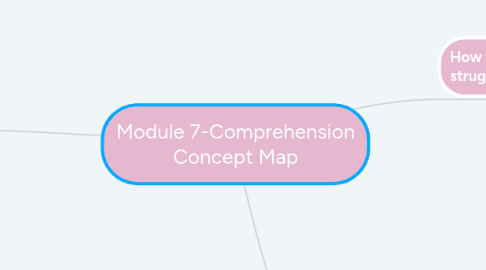
1. Possible Assessment Propositions
1.1. Cloze Assessment
1.1.1. Involves deleting words from the text selection and asking students to replace the words through the use of context clues.
1.1.2. Advantages to this assessment are it can be given in a group setting. It does not require any type of comprehension questions and the scores correlate more highly with more conventional comprehension methods. It is also practical to use with ESL students.
1.2. Questions
1.2.1. Literal Questions require students to answer comprehension questions based on facts from the text.
1.2.2. Inferential Questions are based on factual evidence that is not provided in the text. Students must take the information they have gained and infer what could happen based on this information.
1.2.3. Critical Questions are based on judgement and do not have a right or wrong response. They are not based on facts but based on student values.
1.3. Maze Assessment
1.3.1. Multiple choice version of the Cloze assessment.
1.3.2. This assessment can be administered individually or in a group setting through either the use of computers or manually.
1.3.3. The students have 3 word options to chose from to complete the missing word in the sentence. The word options must have two words of the same part of speech and a distractor.
1.4. Oral Retelings
1.4.1. A checklist is usually provided when administering oral retellings.
1.4.2. Advantages include the act of being natural, avoiding questioning pitfalls and the ability to gauge how well a student internalized the events in the text.
1.4.3. Limitations that are present are they rely on a student's ability to orally communicate and their score maybe skewed based on any deficiencies that they may have with that skill.
1.5. Written Responses
1.5.1. For this method to be effective, students must practice a variety of different ways to respond to books and the teacher must provide ample direct instruction on how to correctly compose.
1.5.2. It is recommended to use a rubric to score these responses that come from PARCC or Smarter Balance to familiarize students with what is expected of them during mandated state assessments.
1.6. Word Lists
1.6.1. This provides a shortcut by analyzing how a student pronounces words. The scores from this allow the criteria to produce an instructional level for the student.
1.6.2. A downside to this shortcut method is the thought of the validity behind it and should be used more to determine what text level to begin students at.
1.7. Readability
1.7.1. This term refers to the difficulty of the text selection at the determined grade level.
1.7.2. The Fountas and Pinnell leveling text criteria is the most popular assessment to determine readability.
1.7.3. Lexile has since taken over as the most common assessment tool for teachers to determine a student's reading level.
1.8. Reading Dependency
1.8.1. Questions that are not based on reading dependency will not produce an accurate indicator of a student's comprehension abilities.
1.8.2. Students must be able to read a selection first before answering in order for the questions to be deemed reading dependent.
1.9. Other Assessment Formats
1.9.1. Oral Miscue Analysis
1.9.2. Sentence Verification
1.9.3. Student Generated Questions
1.9.4. Performance Tasks
1.9.5. Evaluation of Student Participation
2. How to help students who are struggling with comprehension
2.1. Is the student having decoding difficulties?
2.1.1. If a child is able to listen to a story or text read aloud to them and can understand what is happening, then the student is experiencing difficulties with decoding which is affecting their comprehension.
2.1.2. Students who constantly have to take time to decode words and often are pausing have a harder time comprehending what they read based on the fluency not being adequate.
2.1.3. Students prior knowledge is linked directly to their ability to comprehend certain topics.
2.2. Is the student's prior knowledge causing a disconnect with their ability to comprehend?
2.2.1. Before reading a new text, picture walks, vocabuary building to gain background knowledge of the topic are very important in growing students' ability to comprehend the material at hand.
2.2.2. An activity to keep in mind when working on this skill with students is to read-listen-discuss the text.
2.3. Does the student have a deficiency in his or her comprehension strategies?
2.3.1. Just like students need strategies for decoding, students also need strategies to help them comprehend.
2.3.2. These strategies can be developed through the use of direct instruction, think aloud, questioning, graphic organizers and written and oral retelling of the text.
3. Why should we as teachers assess comprehension?
3.1. To see the overall performance of a student's comprehension ability and to determine what skills they may be lacking and to determine the student's reading abilities
3.1.1. This can be accomplished through the use of chapter tests, Informal Reading Inventories, Selection Tests, District Mandated Achievement Tests and

